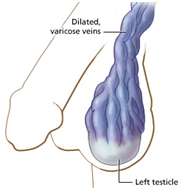Varicoceles are a relatively common condition (affecting approximately 10 percent of men) that tends to occur in young men, usually during the second or third decade of life. Sometimes, these varicoceles cause no symptoms and are harmless. But sometimes a varicocele causes pain or atrophy (shrinkage), or fertility problems.
Normally, blood flows to the testicles through an artery, and flows out via a network of tiny veins that drain into a long vein that goes up through the abdomen. The direction of blood flow in this vein should always be up, toward the heart. A series of one-way valves in the vein prevent the reverse flow of blood back to the testicles.

Varicocele Surgery is usually performed under general anesthesia. Occasionally, the surgery is performed with a local anesthetic. In this type of varicocele treatment, the surgeon makes an incision above the scrotum (or higher in the flank area) and cuts through the layers of tissue to expose the veins (see Figure).
Non-surgical catheter directed embolization is an outpatient treatment. Specifically trained interventional radiologist makes a tiny nick in the skin at the groin or neck using local anesthesia and a thin catheter is passed and directed to the testicular vein. With contrast dye injection, interventional radiologist map out exactly where the problem is and by using coils,

Rawal Sanjay, 24 male
Mumbai, INDIA
"To hear that it was a painless procedure with only one day of recovery sounded amazing.
I had on & off pain since last 6 months in my left testicles and then I saw some prominent veins. I visited my urologist who recommended a surgery as the treatment option but I didn’t want any scar in my Groin area. I visited another general surgeon; he also suggested the same surgery. One day I was just browsing internet & found...
Mr. Raman, 32 male
New Delhi, INDIA
"We knew we were in good hands and our son is proof of that."
When my wife was not conceiving, I was referred to an urologist. A few tests and an ultrasound determined that I had varicocele, which had lowered my sperm count.
I was surfing the internet and I found well known New Delhi based an interventional radiologist, Dr. Pradeep Muley, MD, who performed varicocele embolization which fully repaired my [left and right] varicoceles...
Rajkumar 37 male
New Delhi, India
"Painless procedure with only one day of recovery felt like a dream treatment compared to the pain and long recovery I had gone through with the open surgery before.
I had two separate and painful surgeries to repair my varicocele 17 years ago. My wife and I thought that this problem would be gone permanently, but when the condition reappeared four years ago with pain in my left testicles and prominent veins...